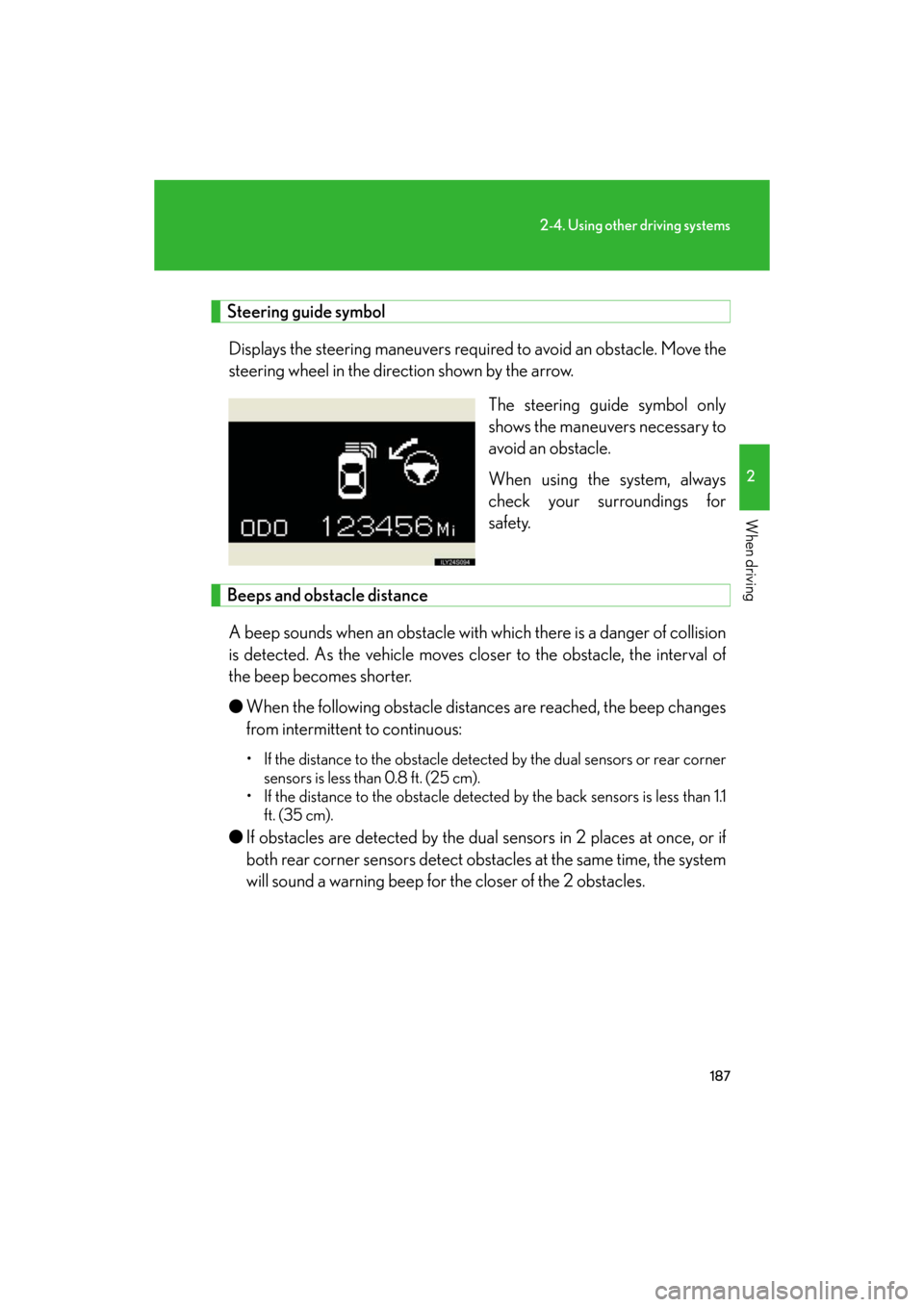wheel Lexus GS450h 2008 Using the audio system / LEXUS 2008 GS450H (OM30A96U) Owner's Guide
[x] Cancel search | Manufacturer: LEXUS, Model Year: 2008, Model line: GS450h, Model: Lexus GS450h 2008Pages: 596, PDF Size: 9.36 MB
Page 132 of 596

132
2-1. Driving procedures
GS_HV_U
May 13, 2008 3:11 pm
CAUTION
■When driving the vehicle
●Do not shift the shift lever to “N” while the vehicle is moving.
Doing so may cause the engine brake not to operate properly and lead to an
accident.
●Do not turn the hybrid system off while driving.
The power steering and brake actuator will not operate properly if the hybrid sys-
tem is off.
●Use engine braking (downshift) to maintain a safe speed when driving down a
steep hill.
Using the brakes continuously may cause the brakes to overheat and lose effec-
tiveness. ( P. 144)
●When stopped on an inclined surface, use the brake pedal and parking brake to
prevent the vehicle from rolling backwa rd or forward and causing an accident.
●Be careful when driving on slippery surfaces, as the vehicle may spin or skid when
downshifting, rapidly accelerating, braking or turning.
●Do not adjust the position of the steering wheel, the seat, or the inside or outside
rear view mirrors while driving.
Doing so may result in a loss of vehicle control that can cause accidents that may
result in death or serious injury.
●Always check that all passengers’ arms, heads or other parts of their bodies are
not outside the vehicle, as this may result in death or serious injury.
●Do not drive in excess of the speed limit. Even if the legal speed limit permits it, do
not drive over 85 mph (140 km/h) unless your vehicle has high-speed capability
tires. Driving over 85 mph (140 km/h) may result in tire failure, loss of control and
possible injury. Be sure to consult a tire dealer to determine whether the tires on
your vehicle are high-speed capability tires or not before driving at such speeds.
●The driver should pay attention to pedest rians when the vehicle is powered only
by the electric motor (traction motor). Because there is no engine sounds, the
pedestrians may misjudge the vehicle’s movement.
Page 136 of 596

136
2-1. Driving procedures
GS_HV_U
May 13, 2008 3:11 pm
NOTICE
■While driving the vehicle
Do not use the accelerator pedal or depress accelerator and brake pedals together
to hold the vehicle on a hill.
■When parking the vehicle
Always put the shift lever in “P”. Failure to do so may cause the vehicle to move or
the vehicle may accelerate suddenly if the accelerator pedal is accidentally
depressed.
■Avoiding damage to vehicle parts
●Do not turn the steering wheel fully in either direction and hold it there for a long
time.
Doing so may damage the power steering motor.
●When driving over bumps in the road, drive as slowly as possible to avoid damag-
ing the wheels, underside of the vehicle, etc.
■If you hear a squealing or scraping no ise (brake pad wear limit indicators)
Have your Lexus dealer check and replac e the brake pads as soon as possible.
The rotor damage can result if the pads are not replaced when needed.
Front brake only: Moderate levels of the brake pad and disc wear allow enhanced
front braking power. As a result, the discs may wear more quickly than conventional
brake discs. Therefore, when replacing the brake pads, Lexus recommends that you
also have the thickness of the discs measured.
It is dangerous to drive the vehicle when the wear limits of the brake pads and/or
that of the brake discs are exceeded.
Page 137 of 596

137
2-1. Driving procedures
2
When driving
GS_HV_U
May 13, 2008 3:11 pm
NOTICE
■If you get a flat tire while driving
A flat or damaged tire may cause the following situations. Hold the steering wheel
firmly and gradually press the brake pedal to slow down the vehicle.
●It may be difficult to control your vehicle.
●The vehicle will make abnormal sounds.
●The vehicle will behave abnormally.
Replace a flat tire with a new one. ( P. 5 2 0 )
■When encountering flooded roads
Do not drive on a road that has flooded after heavy rain etc. Doing so may cause the
following serious damage to the vehicle.
●Engine stalling
●Short in electrical components
●Engine damage caused by water immersion
In the event that you drive on a flooded road and the vehicle is flooded, be sure to
have your Lexus dealer check the following.
●Brake function
●Changes in quantity and quality of oil an d fluid used for the engine, transmission,
differentials, etc.
●Lubricant condition for the propeller shaft, bearings and suspension joints (where
possible) and the function of all joints, bearings, etc.
Page 140 of 596

140
2-1. Driving procedures
GS_HV_U
May 13, 2008 3:11 pm
■If the hybrid system does not start
The immobilizer system may not have been deactivated. (P. 88)
■When the steering lock cannot be released
■When the “POWER” switch indicator flashes in amber
The system may be malfunctioning. Have the vehicle inspected by your Lexus
dealer immediately.
■If the “READY” light does not come on
If the “READY” light does not come on when you press the “POWER” switch with
the shift lever in “P” and the brake pedal pressed, contact your Lexus dealer imme-
diately.
■Auto power OFF function
If the vehicle is left in the ACCESSORY mode for more than an hour with the shift
lever in “P”, the “POWER” switch will automatically turn OFF.
■When the ambient temperature is low
Such as during winter driving conditions, it may take time until the “READY” light
comes on.
■Sounds and vibrations specific to a hybrid vehicle
P. 2 5
■When the hybrid system is malfunctioning
P. 5 0 0
The green indicator light on the “POWER”
switch will flash and a message will be shown
on the multi-information display. Press the
“POWER” switch again while turning the
steering wheel left and right.
Page 178 of 596

178
2-4. Using other driving systems
GS_HV_U
January 4, 2008 10:02 am
CAUTION
■When the radar sensor may not be correctly detecting the vehicle ahead
Apply the brakes as necessary when any of the following types of vehicles are in
front of you.
As the sensor may not be able to correctly detect these types of vehicles, the prox-
imity alarm ( P. 509) will not be activated, and an accident may result.
●Vehicles that cut in suddenly
●Vehicles traveling at low speeds
●Vehicles that are not moving
●Vehicles with small rear ends (tra ilers with no load on board etc.)
●Motorcycles traveling in the same lane
■Conditions under which the vehicle-to-vehicle distance control may not function
correctly
Apply the brakes as necessary in the foll owing conditions as the radar sensor may
not be able to correctly detect vehicles ahead, and an accident may result.
●When water or snow thrown up by the surrounding vehicles hinders the function-
ing of the sensor
●When your vehicle is pointing upwards (caused by a heavy load in the trunk, etc.)
●When the road curves or when the lanes are narrow
●When steering wheel operation or your position in the lane is unstable
●When the vehicle ahead of you decelerates suddenly
Page 180 of 596

180
2-4. Using other driving systems
GS_HV_U
January 4, 2008 10:02 am
Intuitive parking assist (if equipped)
Intuitive parking assist uses sensors in the front and rear of the vehicle to
detect the distance between the vehicle and any obstacles, and informs the
driver of this distance using the mult i-information display, the touch screen,
and warning beeps.
The system may be used at speeds less than about 6 mph (10 km/h).
■ Sensor types
Dual sensors
There are 4 sensors installed in the front bumper, two in the center section
to detect obstacles directly ahead, an d one in each corner of the bumper,
to detect obstacles in those areas.
The dual sensors detect obstacles ahea d of the vehicle, and judge whether
avoidance maneuvers are necessary (whether the obstacle will come
within 0.8 ft. [25 cm] of the vehicl e), according to the distance between
the obstacle and the vehicle, and the steering wheel position. The screen
display and beeps will change accordingly.
Rear corner sensors
These sensors detect obstacles around the rear corners of the vehicle.
Back sensors
These sensors detect obstacles behind the vehicle.
Page 187 of 596

187
2-4. Using other driving systems
2
When driving
GS_HV_U
January 4, 2008 10:02 am
Steering guide symbolDisplays the steering mane uvers required to avoid an obstacle. Move the
steering wheel in the direction shown by the arrow.
The steering guide symbol only
shows the maneuvers necessary to
avoid an obstacle.
When using the system, always
check your surroundings for
safety.
Beeps and obstacle distance
A beep sounds when an obstacle with which there is a danger of collision
is detected. As the vehicle moves clos er to the obstacle, the interval of
the beep becomes shorter.
● When the following obstacle distan ces are reached, the beep changes
from intermittent to continuous:
• If the distance to the obstacle detected by the dual sensors or rear corner
sensors is less than 0.8 ft. (25 cm).
• If the distance to the obstacle detected by the back sensors is less than 1.1
ft. (35 cm).
● If obstacles are detected by the dual sensors in 2 places at once, or if
both rear corner sensors detect obst acles at the same time, the system
will sound a warning beep for the closer of the 2 obstacles.
Page 193 of 596

193
2-4. Using other driving systems
2
When driving
GS_HV_U
January 4, 2008 10:02 am
■CertificationFor vehicles sold in the U.S.A.
For vehicles sold in Canada
CAUTION
■While driving
To reduce the chance of injury in the event of an accident or sudden stop, keep the
switch box closed.
■When using the intuitive parking assist
Observe the following precautions.
●The back sensors and rear corner sensors do not judge whether there is danger
of a collision, nor whether the obstacle can be avoided using the steering wheel.
When reversing, always check your surroundings and behind the vehicle for
safety.
●The steering guide symbol (arrow) is an approximate guide regarding obstacles.
It is not driving instructions. When movi ng forward or reversing, always check
your surroundings for safety and drive carefully.
●Do not install accessories within the sensors’ detection areas, as this may cause
the intuitive parking assist to function inco rrectly, possibly leading to an accident.
This device complies with Part 15 of the FCC Rules.
Operation is subject to the following two conditions;
(1) This device may not cause harmful interference, and
(2) This device must accept any interference received, including interference
that may cause undesired operation.
This ISM device complies with Canadian ICES-001.
Cet appareil ISM est conforme a la norme NMB-001 du Canada.
Page 194 of 596

194
2-4. Using other driving systems
GS_HV_U
January 4, 2008 10:02 am
NOTICE
■When using the intuitive parking assist
In the following situations, the system may not function correctly due to a sensor
malfunction etc. Have the vehicle checked by your Lexus dealer.
●A beep does not sound when you turn the main switch on.
●The intuitive parking assist operation display flashes, and a beep sound when no
obstacle has been detected.
●If the area around a sensor collides with something, or is subjected to strong
impact.
●If the bumper collides with something.
●If the display shows continuously without a beep.
■When changing tires
If you install tires of a size other than that recommended by the manufacturer, the
system will be unable to correctly detect steering wheel movement. Always use tire
sizes recommended by the manufacturer.
■When washing the vehicle
When washing the vehicle using high pressure cleaning equipment, do not spray
water directly on the sensors. Subjecting the sensors to high pressure impact may
cause a malfunction.
Page 199 of 596

199
2-4. Using other driving systems
2
When driving
GS_HV_U
January 4, 2008 10:02 am
AVS (Adaptive Variable Suspension System)
AVS controls the suspension according to the road and driving conditions.
Selecting an optimum driving mode allows good vehicle posture and steer-
ing wheel operation in conjunction with VGRS, EPS and active stabilizer
suspension system (if equipped).
Sports mode
For winding mountain road driv-
ing or high speed driving.
Normal mode
For normal driving.